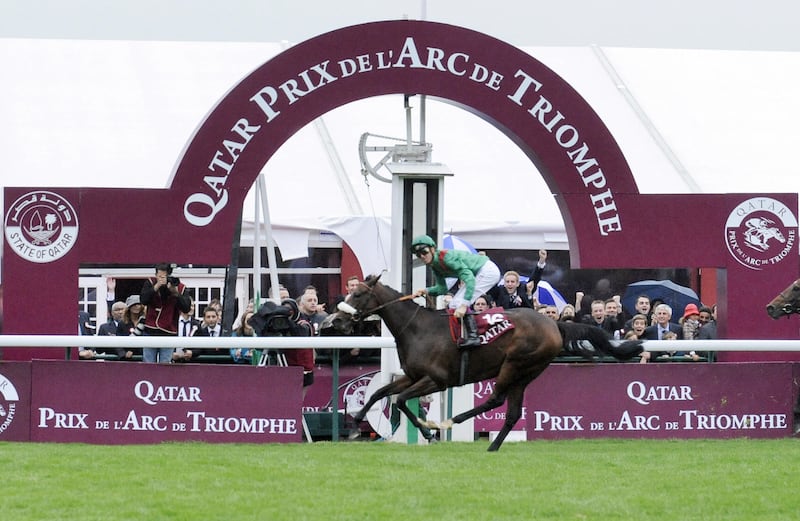Aga Khan IV, who bred and owned the magnificent, ill-starred Derby winner, Shergar, among dozens of champions to carry his famous green and red colours over the course of six decades in the sport, has died at the age of 88.
Shergar was the most emphatic Derby winner in the Classic’s 202-year history when he romped to a 10-length success under a 19-year-old Walter Swinburn at Epsom in June 1981. But it was his subsequent kidnapping from the Aga’s Ballymany Stud in Co Kildare by an armed gang in February 1983, barely a year after his retirement from the track, that projected Shergar on to the front pages of newspapers around the globe.
The gang, believed to have been members of the Provisional IRA, held the family of James Fitzgerald, Shergar’s stud groom, at gunpoint while Fitzgerald was ordered to lead the stallion into a horsebox. Fitzgerald was then forced into another car and driven around the local area before being left at the roadside having been supplied with a code-word that the kidnappers intended to use in negotiations.
The days that followed were the opening chapters of a mystery that remains unresolved more than 40 years later. A Garda investigation of the kidnapping swiftly descended into the realms of farce, including an attempt to use a clairvoyant to divine Shergar’s whereabouts.
READ MORE
Negotiations also began between the kidnappers and the stallion’s group of owners – the Aga Khan, by this point, had only a minority stake as Shergar had been syndicated into 40 shares – but broke off after four days when the owners did not accept an attempt by the kidnappers to prove that Shergar was still alive.
Shergar was never seen again and his final resting place too remains unknown, although in the aftermath of the Troubles, a number of second-hand accounts by former IRA members emerged which seem to outline a plot that was ill-conceived from the start.
In particular, the gang members sent to steal the five-year-old had no experience with handling a highly-strung, full-grown thoroughbred stallion, and one account suggests that Shergar was shot only a few hours after his abduction after he became panicked and out of control, before being buried in remote mountains near the Border.

The loss of one of the greatest of all Derby winners from the Aga Khan’s breeding operation after siring just 35 foals was a significant setback for an owner-breeder who inherited an extensive bloodstock operation from his father, in 1960. But his lifelong passion for breeding and racing thoroughbreds ensured that many more outstanding champions raced in his colours.
The Aga Khan owned five Derby winners in all – Shahrastani (1986), Kahyasi (1988), Sinndar (2000) and Harzand (2016) were the others – and four winners of the Prix de l’Arc De Triomphe, including the brilliant, unbeaten filly Zarkava in 2008.
There were other moments of controversy too, not least after the victory of Aliysa in the Oaks in 1989, the Aga Khan’s first in the Epsom fillies’ Classic. The three-year-old was an easy and impressive three-length winner, but a month later the Jockey Club, the sport’s regulator at the time in Britain, announced that Aliysa’s post-race urine test had been positive for camphor, a banned substance.
The rules of racing were clear that Aliysa had to be disqualified, and while her owner mounted a sustained legal challenge to the Jockey Club’s testing procedures, the decision to award the race to Snow Bride, the runner-up, was finally confirmed in December 1990, 18 months after the Oaks.
The Aga Khan immediately removed all 90 of his horses in training in Britain, most of which were stabled with Michael Stoute and Luca Cumani in Newmarket, and his colours were absent from British racecourses for several years.
Instead, he turned his focus to expanding his racing and breeding operations in France, where his outstanding Arc winners, Dalakhani and Zarkava, were both trained, and also in Ireland, where Dermot Weld – the trainer of Harzand – and John Oxx had significant strings of horses in his colours.
The late Aga Khan built on the legacy of both his father – who owned the brilliant racemare, Petite Etoile – and his grandfather, who also owned five Derby winners between 1930 and 1952, including Mahmoud (1936), for many years the holder of the record time for a Derby winner, and Tulyar (1952).
Aga Khan IV’s daughter, Princess Zahra Aga Khan, is also an enthusiastic owner and breeder whose winners to date include Mandesha, the 2006 Prix Vermeille winner. Her colours – green with brown epaulettes – blend her father’s silks with those of his predecessors as Aga Khan – green and chocolate hoops – and seem likely to extend the family’s bloodstock operation into a fourth generation. – Guardian
- Sign up for push alerts and have the best news, analysis and comment delivered directly to your phone
- Join The Irish Times on WhatsApp and stay up to date
- Listen to the Counter Ruck podcast for the best rugby chat and analysis















